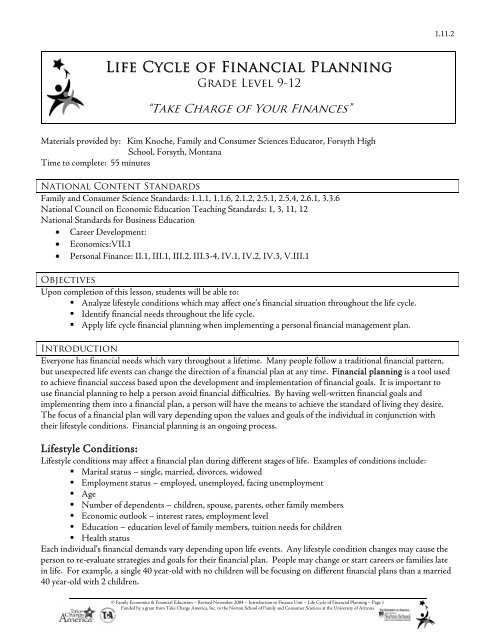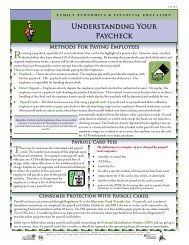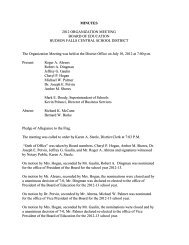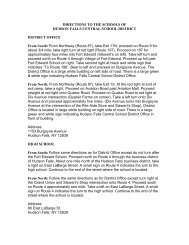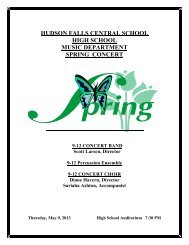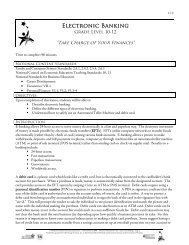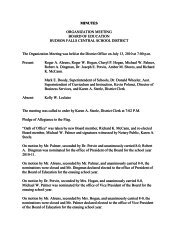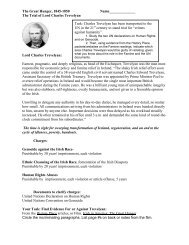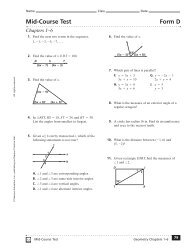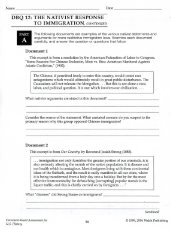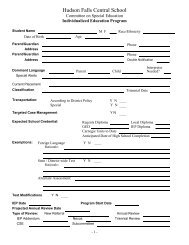Life Cycle of Financial Planning Lesson Plan
Life Cycle of Financial Planning Lesson Plan
Life Cycle of Financial Planning Lesson Plan
- No tags were found...
You also want an ePaper? Increase the reach of your titles
YUMPU automatically turns print PDFs into web optimized ePapers that Google loves.
1.11.2<strong>Life</strong> <strong>Cycle</strong> <strong>of</strong> <strong>Financial</strong> <strong><strong>Plan</strong>ning</strong>Grade Level 9-12“Take Charge <strong>of</strong> Your Finances”Materials provided by: Kim Knoche, Family and Consumer Sciences Educator, Forsyth HighSchool, Forsyth, MontanaTime to complete: 55 minutesNational Content StandardsFamily and Consumer Science Standards: 1.1.1, 1.1.6, 2.1.2, 2.5.1, 2.5.4, 2.6.1, 3.3.6National Council on Economic Education Teaching Standards: 1, 3, 11, 12National Standards for Business Education• Career Development:• Economics:VII.1• Personal Finance: II.1, III.1, III.2, III.3-4, IV.1, IV.2, IV.3, V.III.1ObjectivesUpon completion <strong>of</strong> this lesson, students will be able to:• Analyze lifestyle conditions which may affect one’s financial situation throughout the life cycle.• Identify financial needs throughout the life cycle.• Apply life cycle financial planning when implementing a personal financial management plan.IntroductionEveryone has financial needs which vary throughout a lifetime. Many people follow a traditional financial pattern,but unexpected life events can change the direction <strong>of</strong> a financial plan at any time. <strong>Financial</strong> planning is a tool usedto achieve financial success based upon the development and implementation <strong>of</strong> financial goals. It is important touse financial planning to help a person avoid financial difficulties. By having well-written financial goals andimplementing them into a financial plan, a person will have the means to achieve the standard <strong>of</strong> living they desire.The focus <strong>of</strong> a financial plan will vary depending upon the values and goals <strong>of</strong> the individual in conjunction withtheir lifestyle conditions. <strong>Financial</strong> planning is an ongoing process.<strong>Life</strong>style Conditions:<strong>Life</strong>style conditions may affect a financial plan during different stages <strong>of</strong> life. Examples <strong>of</strong> conditions include:• Marital status – single, married, divorces, widowed• Employment status – employed, unemployed, facing unemployment• Age• Number <strong>of</strong> dependents – children, spouse, parents, other family members• Economic outlook – interest rates, employment level• Education – education level <strong>of</strong> family members, tuition needs for children• Health statusEach individual’s financial demands vary depending upon life events. Any lifestyle condition changes may cause theperson to re-evaluate strategies and goals for their financial plan. People may change or start careers or families latein life. For example, a single 40 year-old with no children will be focusing on different financial plans than a married40 year-old with 2 children.© Family Economics & <strong>Financial</strong> Education – Revised November 2004 – Introduction to Finance Unit – <strong>Life</strong> <strong>Cycle</strong> <strong>of</strong> <strong>Financial</strong> <strong><strong>Plan</strong>ning</strong> – Page 1Funded by a grant from Take Charge America, Inc. to the Norton School <strong>of</strong> Family and Consumer Sciences at the University <strong>of</strong> Arizona
1.11.2<strong>Financial</strong> <strong>Life</strong> <strong>Cycle</strong>:Each individual or family will set specific financial goals to be met during their life cycle. This information isdepicted on An Individual’s <strong>Financial</strong> <strong>Life</strong> <strong>Cycle</strong> graph 1.11.2.D2. The bell curve represents the traditional wealthone has over the life cycle in three stages.• Stage 1: Basic Wealth Protectiono The beginning <strong>of</strong> the curve is where a person ‘quits giving money to others’ and is the familyformation stage for many people. This is when an individual may be beginning to earn money,continuing education, starting a job or career, and/or starting a family. The individual should befocusing on gaining wealth and earnings.• Stage 2: Wealth Accumulationo The second stage is where a person is ‘giving the money to self.’ The household head has reachedpeak earning years, is accumulating wealth, and approaching retirement.• Stage 3: Wealth Distributiono The last stage involves ‘giving the money to your chosen ones.’ The stage is also known asretirement, where consumption <strong>of</strong> wealth occurs, and involves estate planning.Personal <strong>Financial</strong> Management Pyramid:The levels which contribute to a well-managed and balanced financial plan are shown on the Personal <strong>Financial</strong>Management Pyramid 1.11.2.D1. It starts with basic financial requirements on the bottom, focuses on wealthaccumulation in the middle, and moves up the pyramid to distribution <strong>of</strong> wealth as the final financial plan. Thepyramid is based on a hierarchy where decisions at one level affect the other levels. As a person moves up thepyramid, their financial plan becomes more complex.<strong>Life</strong> <strong>Cycle</strong> Needs:A life cycle is defined as a series <strong>of</strong> stages in which an individual passes during his or her lifetime.The following are life cycle needs (activities and events) which would require financial planning for different agegroups:High School: Ages 13 – 17• Developing plan for eventualindependence• Preparing for career• Evaluating future financial needs andresources• Exploring financial systems• Developing a personal system <strong>of</strong> recordkeepingAdult with or without Children: Ages 25 – 34• Child-bearing• Child-raising• Education fund started• Expand career goals• Manage increased need for credit• Training expensesYoung Adult: Ages 18 – 24• Establishing a household• Training for a career• Earning financial independence• Determining insurance needs• Establishing credit• Establishing savings• Creating a spending plan• Developing a personal financial identity• Developing a personal financial planningsystem• Repaying debtWorking Parent or Adult: Ages 35-44• Upgrade career training• Build education fund• Head-<strong>of</strong>-household protection needs• Need for greater income due toexpanding needs• Establish retirement goals© Family Economics & <strong>Financial</strong> Education – Revised November 2004 – Introduction to Finance Unit – <strong>Life</strong> <strong>Cycle</strong> <strong>of</strong> <strong>Financial</strong> <strong><strong>Plan</strong>ning</strong> – Page 2Funded by a grant from Take Charge America, Inc. to the Norton School <strong>of</strong> Family and Consumer Sciences at the University <strong>of</strong> Arizona
1.11.2• Additional insurance needs• Draw up will• Maximize financial management by allmembers <strong>of</strong> household• Repayment <strong>of</strong> debtMidlife: Ages 45 – 54• Higher education for children• Investments• Update retirement plans• Estate plansRetired: Ages 65 and over• Re-evaluate and adjust living conditionsand spending as related to health andincome• Adjust insurance programs forincreasing risks• Acquire assistance in management <strong>of</strong>personal and financial affairs• Finalize estate plan• Finalize will or letter <strong>of</strong> last instructions• Repayment <strong>of</strong> debtPre-Retirement: Ages 55-64• Consolidate assets• Future security• Re-evaluate property transfer (estate)• Investigate retirement part-time incomeor volunteer work• Evaluate expense for retirement andcurrent housing• Meet responsibilities <strong>of</strong> aging parentsIn this lesson, students brainstorm activities and events which occur around different life cycle age groups whichaffect financial planning. Students develop a financial plan and goals for a scenario <strong>of</strong> a high school student and alsoapply life cycle financial planning to their own lives.Body1. Write the following statement on the board before students enter the room.a. “Everyone follows the same financial plan.”2. At the beginning <strong>of</strong> class, ask the students to read the comment on the board. Ask if it is true or false andwhy or why not. Have a five minute discussion about the statement.3. Tell students this statement is NOT true because people do not have exactly the same life experiences,major life events, or financial plan. Each individual and family’s life cycle financial plan will vary. <strong>Financial</strong>planning is a tool used to achieve financial success based upon the development and implementation <strong>of</strong>financial goals. Give the students examples <strong>of</strong> lifestyle conditions which may occur to change the financialplan <strong>of</strong> an individual or family including:a. Marital status – single, married, divorced, widowedb. Employment status – employed, unemployed, facing unemploymentc. Aged. Number <strong>of</strong> dependents – children, spouse, parents, other family memberse. Economic outlook – interest rates, employment level, salary ratesf. Education – education level <strong>of</strong> family members, tuition needs for childreng. Health statush. For example, a 17 year-old single mother’s financial plan is different than a 17 year-old studentwithout a child.4. Discuss An Individual’s <strong>Financial</strong> <strong>Life</strong> <strong>Cycle</strong> graph 1.11.2.D2.© Family Economics & <strong>Financial</strong> Education – Revised November 2004 – Introduction to Finance Unit – <strong>Life</strong> <strong>Cycle</strong> <strong>of</strong> <strong>Financial</strong> <strong><strong>Plan</strong>ning</strong> – Page 3Funded by a grant from Take Charge America, Inc. to the Norton School <strong>of</strong> Family and Consumer Sciences at the University <strong>of</strong> Arizona
1.11.2a. The bell curve represents the traditional wealth one accumulates during the life cycle in three stages.b. Stage 1: Basic Wealth Protectioni. The beginning <strong>of</strong> the curve is where a person ‘quits giving money to others’ and is the familyformation stage for many people. This is when an individual may be beginning to earnmoney, continuing education, starting a job or career, and/or starting a family. Theindividual should be focusing on gaining wealth and earnings.c. Stage 2: Wealth Accumulationi. The second stage is where a person is ‘giving the money to self.’ The household head hasreached peak earning years, is accumulating wealth, and approaching retirement.d. Stage 3: Wealth Distributioni. The last stage involves ‘giving the money to your chosen ones.’ The stage is also known asretirement, where consumption <strong>of</strong> wealth occurs, and involves estate planning.5. Discuss the Personal <strong>Financial</strong> Management Pyramid 1.11.2.D1.a. *Note: The graph and pyramid represent the same idea with the graph showing the visual timelineand the pyramid listing things which occur over a life cycle.b. The levels contribute to a well-managed and balanced financial plan recommended for individuals.The levels <strong>of</strong> the pyramid starting at the bottom are as follows:i. Basic Wealth Protection – quit giving it to others1. Cash Management – goal setting, emergency, cash reserve, record keeping,spending plans, net worth, and income-expense statements2. Credit and Debt Management – goal setting, credit use, avoiding credit abuse, anddebt reduction3. Risk and Tax Management – goal setting, insurance, protection against economicloss, and income tax reductionii. Wealth Accumulation – giving it to yourself1. Building <strong>Financial</strong> Security – goal setting, savings plan, home ownership, andchildren’s educationiii. Wealth Distribution – giving it to your chosen ones1. Estate planningc. Discuss how building a solid financial foundation allows a person to build wealth and move up thepyramid.i. It is based on a hierarchy where decisions at one level affect the other levels. As a personmoves up the pyramid, their financial plan becomes more complex.6. Activity – Have the room setup prior to class starting.a. Tape the Age Group Titles 1.11.2.H1 around the room on large pieces <strong>of</strong> white butcher paper.b. Divide the students into groups <strong>of</strong> 3. In the groups, students must brainstorm activities and eventswhich require financial planning for their assigned age group and write their ideas on the butcherpaper.7. After the students are finished brainstorming, gather the class back together for a group discussion.a. Take turns reading and discussing the student’s ideas for each age group starting with the age group13 – 17. Continue to do the same for each age group one at a time (ages 18 – 24, 25-34, 35-44, 45-54, 55-64, and 65+).b. Have the Answer Key 1.11.2.C1 ready to compare to the student’s answers as a guide for events atcertain ages.c. Remember – no answers are right or wrong because the age at which events occur can drasticallyvary among people.8. After the activity, read the following scenario to the students. Ask the students to come up with fourspecific financial goals for the person in the scenario and list a resource for each goal to help her implementthe financial plan. List the financial goals and resources the students came up with on the board.© Family Economics & <strong>Financial</strong> Education – Revised November 2004 – Introduction to Finance Unit – <strong>Life</strong> <strong>Cycle</strong> <strong>of</strong> <strong>Financial</strong> <strong><strong>Plan</strong>ning</strong> – Page 4Funded by a grant from Take Charge America, Inc. to the Norton School <strong>of</strong> Family and Consumer Sciences at the University <strong>of</strong> Arizona
1.11.2a. Sally Smith is a 16 year-old high school junior. She values her close family and dreams <strong>of</strong> having afamily <strong>of</strong> her own someday. She is also very focused on having a successful career in the future.b. *Note to teacher: This is purposefully vague to encourage students to come up with career andfamily ideas that represent their own values rather than simply steering towards traditional ways <strong>of</strong>life. It is important for the students to understand different interpretations <strong>of</strong> this scenario willrequire different resources to implement the financial plans.c. Example <strong>of</strong> a response:i. Sally wants to save $2,000 for a new computer by saving $110 each month for the next yearand a half.ii. Resource – part-time job9. Discuss Sally’s scenario and the answers with the students. Questions to ask include:a. How does this scenario compare to students in this room?b. What financial plan goals listed on the board could apply to students in this room?c. What other financial plan goals are applicable to high school students?d. Name some personal values and goals which affect a high school student’s financial plans. How canthese values and goals affect financial planning?e. List resources available to high school students to help them reach their financial plans.i. Examples: wages, summer job, investments, savings, hobbies, skills, extra-curricularactivities, gifts, scholarshipsf. Why is it important for students to start their financial plans now?ConclusionAfter the activity, read the statement from the beginning <strong>of</strong> class and ask students to give reasons why it is incorrectas a closure discussion.• “Everyone follows the same financial plan.”AssessmentHand out the Personal <strong>Life</strong> <strong>Cycle</strong> <strong>of</strong> <strong>Financial</strong> <strong><strong>Plan</strong>ning</strong> worksheet 1.11.2.A1. Students must complete thisworksheet individually to analyze their current personal financial situation.MaterialsPersonal <strong>Life</strong> <strong>Cycle</strong> <strong>of</strong> <strong>Financial</strong> <strong><strong>Plan</strong>ning</strong> worksheet – 1.11.2.A1Personal <strong>Financial</strong> Management Pyramid – 1.11.2.D1An Individual’s <strong>Financial</strong> <strong>Life</strong> <strong>Cycle</strong> Graph – 1.11.2.D2Age Group Titles – 1.11.2.H1Butcher paperColor markers (one different color for each group)© Family Economics & <strong>Financial</strong> Education – Revised November 2004 – Introduction to Finance Unit – <strong>Life</strong> <strong>Cycle</strong> <strong>of</strong> <strong>Financial</strong> <strong><strong>Plan</strong>ning</strong> – Page 5Funded by a grant from Take Charge America, Inc. to the Norton School <strong>of</strong> Family and Consumer Sciences at the University <strong>of</strong> Arizona
1.11.2.A1WorksheetPersonal <strong>Life</strong> <strong>Cycle</strong> <strong>of</strong> <strong>Financial</strong><strong><strong>Plan</strong>ning</strong>Name_______________Total Points Earned20 Total Points PossiblePercentageDate_______________Directions: Answer the following questions in relation to the ideas presented during the discussion to your ownpersonal financial situation.1. What stage <strong>of</strong> the life cycle are you at currently? (1 point)2. State three specific financial goals in your life cycle financial plan. (3 points)3. List three resources you currently have available to work toward your financial goals.(3 points)4. What are three possible life cycle changes which could affect your current financial plans in the next fiveyears? (3 points)5. List three personal values which affect your financial planning. (3 points)6. Why do financial plans change throughout the life cycle? (1 point)7. List two <strong>of</strong> the financial resources you are counting on to meet your goals in the next five years: (2points)8. List two for the next ten years: (2 points)9. List two other financial resources you could have to meet future needs if you were to begin to developthem now: (2 points)© Family Economics & <strong>Financial</strong> Education – Revised November 2004 – Introduction to Finance Unit – <strong>Life</strong> <strong>Cycle</strong> <strong>of</strong> <strong>Financial</strong> <strong><strong>Plan</strong>ning</strong> – Page 6Funded by a grant from Take Charge America, Inc. to the Norton School <strong>of</strong> Family and Consumer Sciences at the University <strong>of</strong> Arizona
Age Group Titles1.11.2.H1Game CardsHigh SchoolAges 13–17Young AdultAges 18–24Adult with orwithout ChildrenAges 25–34© Family Economics & <strong>Financial</strong> Education – Revised November 2004 – Introduction to Finance Unit – <strong>Life</strong> <strong>Cycle</strong> <strong>of</strong> <strong>Financial</strong> <strong><strong>Plan</strong>ning</strong> – Page 7Funded by a grant from Take Charge America, Inc. to the Norton School <strong>of</strong> Family and Consumer Sciences at the University <strong>of</strong> Arizona
1.11.2.H1Game CardsAge Group Titles continuedWorking Parentor AdultAges 35–44MidlifeAges 45–54Pre-RetirementAges 55–64RetiredAges 65 and older© Family Economics & <strong>Financial</strong> Education – Revised November 2004 – Introduction to Finance Unit – <strong>Life</strong> <strong>Cycle</strong> <strong>of</strong> <strong>Financial</strong> <strong><strong>Plan</strong>ning</strong> – Page 8Funded by a grant from Take Charge America, Inc. to the Norton School <strong>of</strong> Family and Consumer Sciences at the University <strong>of</strong> Arizona


